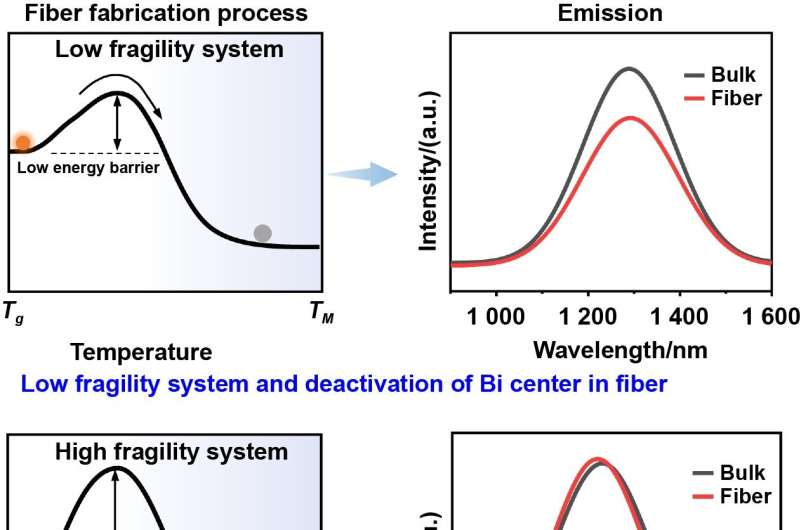
A novel temperature-dependent viscosity-mediated strategy proposed by researchers at the South China University of Technology was able to suppress the deactivation of Bi dopants during the fiber drawing process.
The work could guide the development of heavily doped Bi active fibers, which exhibit great potential for application in the next-generation optical amplifiers.
Bi-dopants exhibit multi-chemical states and can transform into a deactivated state when the bulk is drawn into the fiber at high temperature, which limits the development of high-performance Bi-active fibers.
"From the viewpoint of thermodynamics, the deactivation of Bi dopants cannot be prevented during the fiber drawing process, since the Bi-active center is not the thermodynamics stable at such temperatures," said Shifeng Zhou, corresponding author on the paper and professor at the South China University of Technology.
"Thus, a kinetics strategy must be considered to suppress the transformation of the Bi-active center to an inactive state during the fiber drawing process. Controlling the temperature-dependent viscosity of the materials might be one of the effective kinetic approaches to suppress the deactivation of the Bi center."
Bi-active fiber is now regarded as the most promising candidate for next-generation broadband optical amplifiers in high-capacity telecommunication systems. However, due to the easy deactivation of bi-centers, fabricating Bi-active centers remains a challenge.
Nowadays, only a few groups worldwide can fabricate the Bi-active fiber using the modified chemical vapor deposition (MCVD) method. The complicated chemical vapor deposition (CVD) technique not only creates a significant technique barrier for the fabrication of Bi-active fiber but also limits the available glass fiber system and the doping concentration of Bi.
The evolution of Bi dopant at different temperatures in glass systems with different viscous characteristics is systematically studied. It is found that the systems with a faster viscosity changing rate in the temperature range from 1.0 to 1.6 < I>Tg exhibit better anti-deactivation ability for Bi dopants.
Based on this finding, a borate glass system with a faster viscosity changing rate was developed, and a novel heavily-doped Bi-active borate fiber was fabricated via the simple rod-in-tube method. Additionally, the on-off gain based on the developed novel fiber was demonstrated, marking the first demonstration of on-off gain in a Bi-doped borate fiber system.
"Although achieving a net gain in heavily doped Bi active fiber remains a long-standing challenge," said Prof. Shifeng Zhou, "I think our work may provide new insights into selecting the glass host systems to develop the high-performance Bi-active fibers."
The researchers are continuing the work, aiming to develop the heavily doped Bi-active fibers with net gain and construct the Bi-doped optical amplifiers.
The findings are published in the International Journal of Extreme Manufacturing.
More information: Rui Duan et al, Control of temperature dependent viscosity for manufacturing of Bi-doped active fiber, International Journal of Extreme Manufacturing (2024). DOI: 10.1088/2631-7990/ad3317
Provided by International Journal of Extreme Manufacturing
Citation: Control of temperature dependent viscosity for manufacturing of Bi-doped active fiber (2024, April 17) retrieved 17 April 2024 from https://techxplore.com/news/2024-04-temperature-viscosity-bi-doped-fiber.html
This document is subject to copyright. Apart from any fair dealing for the purpose of private study or research, no part may be reproduced without the written permission. The content is provided for information purposes only.
